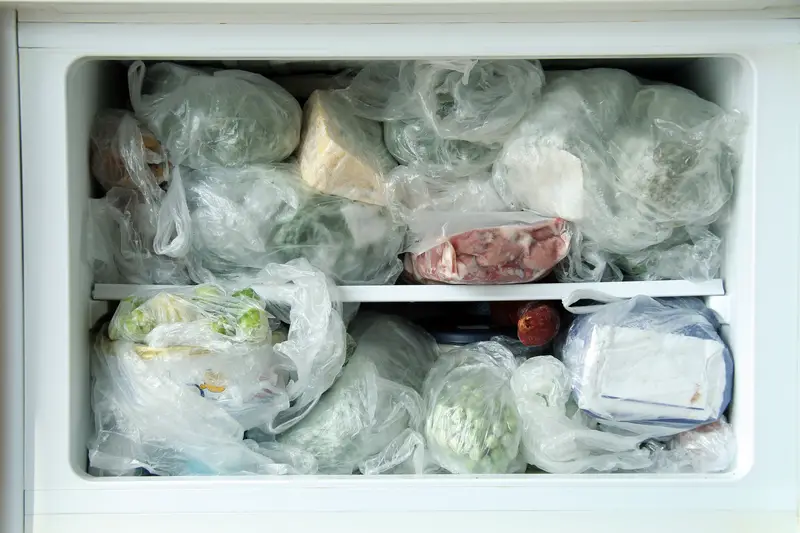Most people think freezing food is foolproof – just toss it in the freezer and forget about it, right? Wrong! There’s one critical mistake that turns perfectly good food into mushy, flavorless disasters, and chances are you’re making it every single day. The truth is, improper freezing techniques waste more food and money than most people realize, turning what should be convenient meal solutions into disappointing kitchen failures.
Freezing hot food destroys everything
Picture this: you’ve just finished cooking a big batch of soup or stew, and you want to freeze half for later. The natural instinct is to pour that steaming hot food directly into containers and stick them in the freezer. This seemingly innocent move is actually a recipe for disaster that ruins both the food you’re trying to preserve and everything else in your freezer. When hot food goes into the freezer, it raises the temperature of the entire compartment, causing other frozen items to partially thaw and refreeze.
The science behind this problem is straightforward but often overlooked. Hot food creates steam and condensation inside containers, leading to ice crystals that destroy the food’s texture and taste. Additionally, the rapid temperature change can cause storage containers to crack or warp. Always let food cool to room temperature first, then refrigerate it before freezing. This simple step prevents bacterial growth and maintains the quality of both the new food and existing frozen items.
Using the wrong containers ruins texture
Not all containers are created equal when it comes to freezing food. Regular storage containers, leftover takeout containers, and random jars might seem like convenient options, but they’re often the wrong choice for long-term freezing. These containers aren’t designed to withstand freezing temperatures and can crack, allowing air to seep in and cause freezer burn. Even worse, some containers can leach chemicals when exposed to extreme cold, affecting both safety and taste.
The key is using containers specifically designed for freezer storage. Freezer-safe containers have thicker walls and better sealing mechanisms that prevent air exposure and maintain consistent temperatures. Glass containers with tight-fitting lids work exceptionally well, as do heavy-duty plastic containers marked as freezer-safe. Avoid using thin plastic bags or containers with loose-fitting lids, as these allow air circulation that leads to freezer burn and off-flavors.
Ignoring air exposure creates freezer burn
Freezer burn isn’t just an aesthetic problem – it’s a texture and flavor destroyer that makes perfectly good food inedible. This happens when air comes into contact with frozen food, causing moisture to evaporate and leaving behind those telltale white, dry patches. Many people think freezer burn means food has gone bad, but it’s actually just severely damaged in terms of quality. The affected areas become tough, chewy, and tasteless, often ruining entire meals.
Preventing freezer burn requires eliminating air exposure as much as possible. When using freezer bags, squeeze out every bit of air before sealing. For containers, fill them as completely as possible, leaving just enough space for expansion. Vacuum-sealed bags offer the best protection for long-term storage, but even pressing out air manually makes a significant difference. Double-wrapping items in plastic wrap before placing them in containers adds an extra layer of protection against air exposure.
Rapid temperature changes destroy cell structure
The speed at which food freezes dramatically affects its final quality, and most home freezers aren’t set up for optimal freezing conditions. When food freezes slowly, large ice crystals form inside the cells, puncturing cell walls and turning previously firm food into mushy disappointments. This is why frozen vegetables often become limp and watery after thawing – the slow freezing process has literally damaged their internal structure beyond repair.
Professional kitchens use blast freezers that freeze food incredibly quickly, forming smaller ice crystals that cause less cellular damage. While home cooks can’t replicate this exactly, there are ways to speed up the freezing process. Spread food in thin layers on baking sheets before transferring to containers, and avoid overcrowding the freezer. Set your freezer to its coldest safe setting (around 0°F) and place new items near the back where temperatures are most consistent. These steps help food freeze faster and maintain better texture when thawed.
Forgetting about expansion causes container explosions
Water expands when it freezes – a basic scientific fact that somehow gets forgotten when people are busy packing food away. This expansion can turn innocent-looking containers into freezer bombs that crack, split, or even explode, creating massive messes and ruining food. Soups, stews, and anything with high water content are particularly prone to this problem. Glass jars are especially dangerous because they can shatter completely, potentially damaging the freezer and contaminating other food.
The solution is simple but often overlooked: always leave expansion room at the top of containers. For most foods, leaving about an inch of space at the top prevents problems. Liquids need even more room – sometimes up to two inches depending on the container size. Wide-mouth containers handle expansion better than narrow ones because they allow the frozen food to expand upward rather than putting pressure on the sides. When in doubt, use slightly larger containers rather than trying to maximize space efficiency.
Poor labeling leads to mystery meals
How many times have you stared at an unlabeled container in your freezer, trying to remember what’s inside and when you put it there? This common scenario leads to food waste and disappointing meals when mystery items turn out to be something completely different than expected. Even worse, some foods look identical when frozen – that container could be soup, sauce, or something entirely different. Without proper labeling, even the most organized people end up with freezer graveyards full of unidentifiable items.
Effective labeling goes beyond just writing the food name. Include the date frozen, the number of servings, and any special reheating instructions. Freezer-safe labels stick better in cold temperatures than regular tape or stickers. Consider using a numbering system with a corresponding list kept on the freezer door for items that are difficult to label directly. Some people even take photos of meals before freezing them, creating a visual reference that makes identification foolproof later on.
Refreezing thawed food creates safety risks
Once food has been completely thawed, putting it back in the freezer seems like a logical way to extend its life. However, this practice significantly degrades food quality and can create safety concerns. Each freeze-thaw cycle damages the food’s cellular structure more severely, resulting in increasingly mushy textures and bland flavors. Additionally, the time spent at unsafe temperatures during thawing allows bacteria to multiply, and refreezing doesn’t eliminate these microorganisms.
The exception to this rule involves cooking thawed food before refreezing it. If you thaw raw meat and cook it into a stew, that cooked stew can safely be frozen again. However, the quality will still suffer compared to food that’s only been frozen once. Plan portion sizes carefully to avoid the temptation to refreeze items. Using portion-sized containers allows you to thaw only what you need, eliminating the refrezing dilemma entirely. When possible, use thawed food within 24-48 hours rather than attempting to preserve it again.
Incorrect thawing methods ruin perfectly good food
The way food is thawed can make or break the entire freezing effort. Leaving frozen food on the counter to thaw might seem convenient, but it’s actually dangerous and damaging. Room temperature thawing allows the outside of food to reach unsafe temperatures while the inside remains frozen, creating perfect conditions for bacterial growth. This method also causes uneven thawing that affects texture and can make food partially cook in some areas while remaining frozen in others.
Safe thawing happens in the refrigerator, where consistent cold temperatures allow gradual, even defrosting. This method takes longer but preserves both safety and quality. For faster results, cold water thawing works well – submerge sealed food in cold water, changing the water every 30 minutes. Defrosting trays can speed up the process safely by conducting cold efficiently. Microwave thawing is acceptable for immediate cooking but often creates hot spots that partially cook food unevenly, affecting the final result’s texture and taste.
Freezing the wrong foods wastes time and money
Not every food is meant to be frozen, and attempting to freeze the wrong items results in disappointing failures that waste both ingredients and effort. High-water content vegetables like lettuce and cucumbers turn into soggy messes when frozen and thawed. Dairy products often separate and become gritty, while eggs in their shells can explode from expansion. Even foods that can technically be frozen might not be worth the effort if they lose too much quality in the process.
Understanding which foods freeze well saves time and prevents disappointment. Soups, stews, and casseroles generally freeze excellently because their mixed textures mask any individual ingredient changes. Bread products freeze beautifully and can be used directly from the freezer in many cases. Focus freezer space on items that maintain quality and save significant time or money, rather than trying to freeze everything just because it’s possible.
Mastering proper freezing techniques transforms this simple preservation method from a source of kitchen disasters into a reliable meal-planning tool. The difference between success and failure often comes down to these basic principles that are easy to implement once you understand them. With the right approach, your freezer becomes a valuable asset that saves time, reduces waste, and ensures delicious meals are always within reach.

